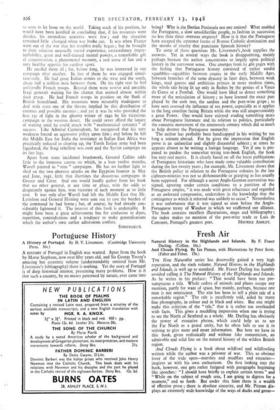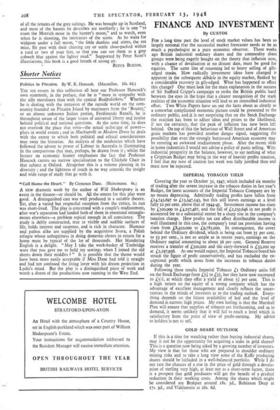Fresh Air
Natural History in the Highlands and Islands. By F. Fraser Darling. (Collins. 16s.) And Clouds Flying. By Ian Pitman, with Illustrations by Peter Scott. (Faber and Faber. 15s.) THE New Naturalist series has deservedly gained a very high reputation, and the sixth volume; Natural History in the Highlands and Islands, is well up to standard. Mr. Fraser Darling has humbly avoided calling it The Natural History of the Highlands and Islands. As he writes in his preface: "That would have been too pre- sumptuous a title. Whole orders of animals and plants escape any mention, partly for want of space, but mainly, perhaps, because one man is not omniscient. The aim has been to tell a plain tale of a remarkable region." The tale is excellently told, aided by many. fine photographs, in colour and in black and white. But one might make this criticism of the "tale," that it is rather too overloaded with facts. This gives a muddling impression when one is trying to see the North of Scotland as a whole. Mr. Darling has obviously the power of evocative phrase, Which could help us to see the Far North as a grand unity, but he often fails to use it in striving to give more and more information. But here we have in this book, given realistically and without fake romanticism, an admirable and solid line on the natural history of the wildest British region.
And Clouds Flying is a book about wildfowl and wildfowling written while the author was a prisoner of war. This so obvious lover of the wide open—marshes and mudflats and estuaries-- inspires us with his own enthusiasm. On first looking into the book, however, one gets rather fatigued with paragraphs beginning like speeches : "I should have briefly to explain certain terms" and "While on the subject of rough seas, I am going to digress for a moment," and so forth. But under this feint there is a wealth of effective prose ; there is absolute sincerity, and Mr. Pitman dis- plays an extremely wide knowledge of the ways of ducks and geese--
of all the tenants of the grey saltings. He was brought up in Scotland, and most of the haunts he describes are northerly ; he is one "to roam the Morrich moor in the hunter's moon," and to watch, even when he is shooting, the intricacies of the scene. As he waits for widgeon under a full moon, "the little dunlins and stints, the sea mice, flit past with their chirring cry or settle close-packed within a yard or two of your feet, so that you can see them as a grey cobweb blur against the lighter mud." Supported by Peter Scott's illustrations, this book is a good breath of strong air.



































 Previous page
Previous page